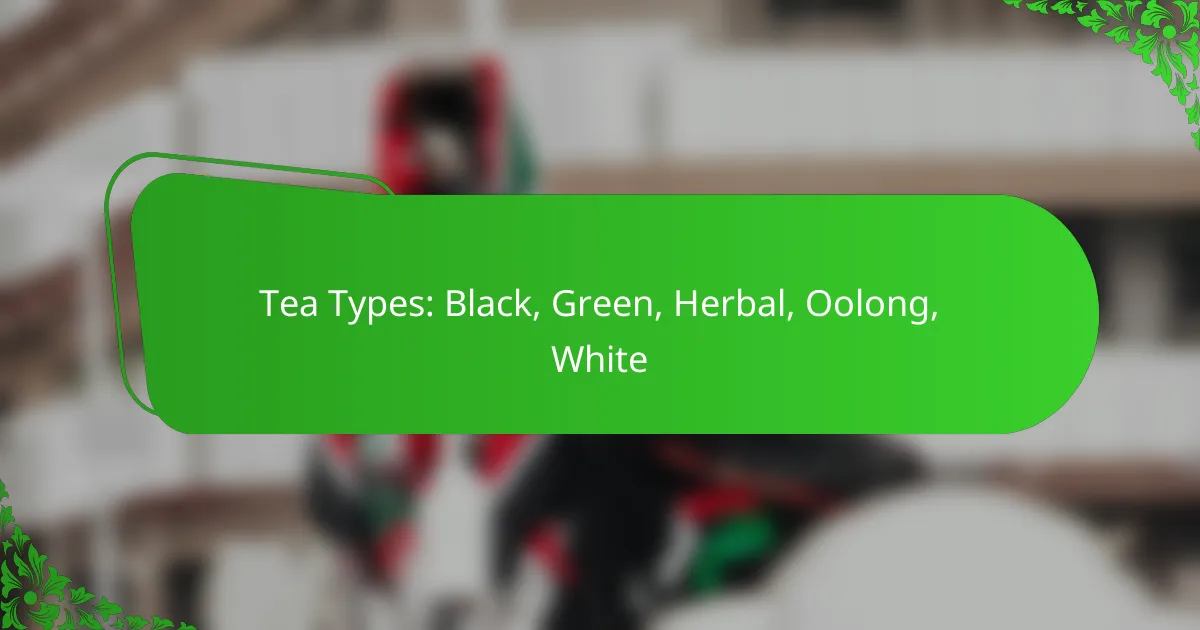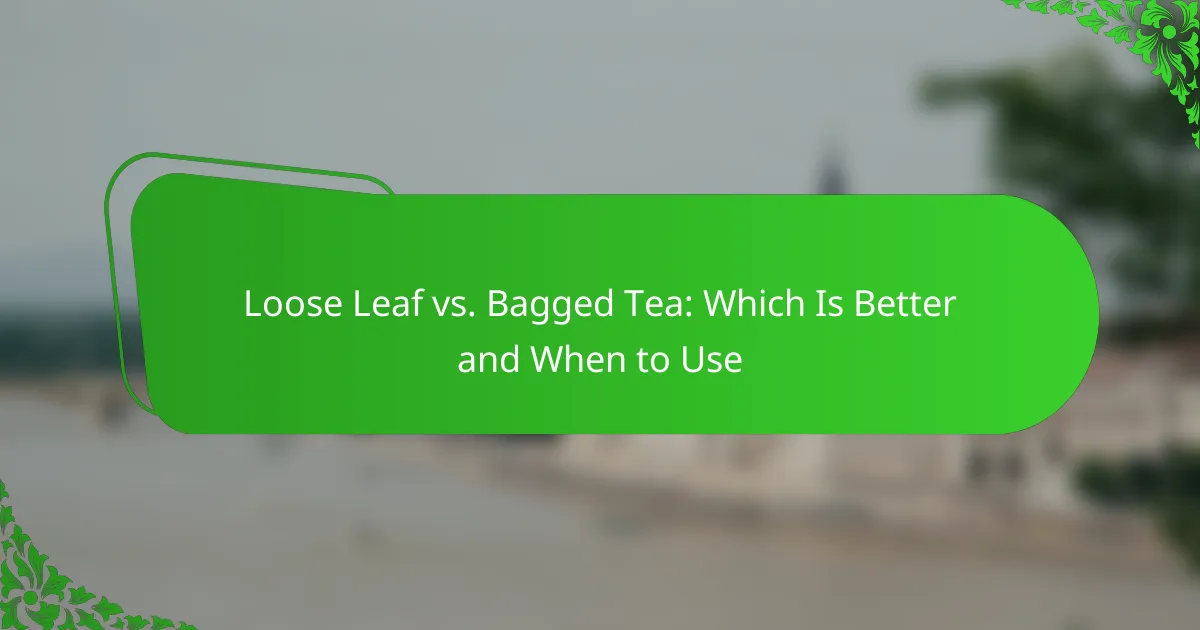Exploring the world of tea involves understanding its diverse flavor profiles, caffeine levels, and aromatic qualities. Each type of tea offers a unique combination of tastes and scents, influenced by its leaves and processing methods. By familiarizing yourself with these characteristics, you can make informed choices that enhance your tea-drinking experience.

What are the best tea selections for flavor profiles?
The best tea selections for flavor profiles vary widely, offering unique tastes and aromas. Understanding these profiles can help you choose the right tea for your preferences or occasions.
Black tea flavor characteristics
Black tea is known for its robust and bold flavor, often featuring malty, astringent, or even smoky notes. Common varieties include Assam, which has a rich and malty profile, and Darjeeling, known for its floral and fruity undertones.
When brewing black tea, aim for water temperatures around 90-100°C (194-212°F) and steep for 3-5 minutes to extract the full flavor. Avoid over-steeping to prevent bitterness.
Green tea flavor characteristics
Green tea typically offers a fresh, grassy flavor with a hint of sweetness. Varieties like Sencha are known for their vegetal notes, while Matcha provides a creamy, umami-rich experience.
For optimal flavor, steep green tea at lower temperatures, around 70-80°C (158-176°F), for 2-3 minutes. This gentle brewing helps preserve its delicate taste and aroma.
Herbal tea flavor characteristics
Herbal teas encompass a wide range of flavors, often derived from flowers, fruits, and herbs. Chamomile is soothing and floral, while peppermint offers a refreshing, minty taste.
Since herbal teas are caffeine-free, they can be steeped at boiling temperatures (100°C or 212°F) for 5-7 minutes to fully extract their flavors. Experimenting with blends can enhance the overall experience.
Oolong tea flavor characteristics
Oolong tea features a complex flavor profile that can range from floral and fruity to rich and toasty, depending on its oxidation level. Tie Guan Yin is a popular variety known for its sweet, floral notes, while Wuyi Oolong has a more roasted, mineral flavor.
To brew oolong tea, use water at around 85-95°C (185-203°F) and steep for 3-5 minutes. Multiple infusions are common, allowing you to discover different flavor layers with each steep.
White tea flavor characteristics
White tea is the most delicate of all tea types, characterized by its subtle, sweet, and light flavor. Silver Needle, a well-known variety, offers a soft, floral taste with a hint of fruitiness.
For brewing white tea, use water at about 70-80°C (158-176°F) and steep for 4-6 minutes. This gentle approach helps maintain its delicate flavor and aroma, making it a refreshing choice.

How does caffeine level vary among different teas?
Caffeine levels in tea can vary significantly based on the type of tea, processing methods, and brewing time. Generally, black tea contains the highest caffeine, while herbal teas typically have little to none.
Caffeine content in black tea
Black tea is known for its robust flavor and higher caffeine content, usually ranging from 40 to 70 mg per 8-ounce cup. The caffeine in black tea can provide a noticeable energy boost, making it a popular choice for morning consumption.
Factors such as steeping time and tea variety can influence the exact caffeine level. For example, Assam black tea tends to have more caffeine than Darjeeling.
Caffeine content in green tea
Green tea generally contains less caffeine than black tea, with levels typically between 20 and 45 mg per 8-ounce cup. This makes it a suitable option for those looking to reduce their caffeine intake while still enjoying a mild stimulant effect.
The caffeine content can vary based on the type of green tea; matcha, for instance, has higher levels due to the consumption of the whole leaf.
Caffeine content in oolong tea
Oolong tea falls between black and green tea in terms of caffeine, with an average range of 30 to 50 mg per 8-ounce cup. The unique processing method of oolong, which involves partial oxidation, contributes to its distinct flavor and moderate caffeine levels.
Brewing time and temperature can also affect caffeine extraction, so adjusting these variables can help tailor the caffeine experience.
Caffeine content in white tea
White tea is the least processed of all tea types and typically contains about 15 to 30 mg of caffeine per 8-ounce cup. This lower caffeine level, combined with its delicate flavor, makes white tea an appealing choice for those sensitive to caffeine.
However, certain varieties, like Silver Needle, can have slightly higher caffeine content, so it’s wise to check specific types if caffeine is a concern.
Caffeine content in herbal tea
Herbal tea is unique as it is not derived from the Camellia sinensis plant and usually contains little to no caffeine. Most herbal blends, such as chamomile or peppermint, are naturally caffeine-free, making them ideal for evening consumption.
Some herbal teas, like yerba mate, can have caffeine, but they are exceptions rather than the rule. Always check the label if you’re looking to avoid caffeine altogether.

What are the aroma profiles of popular teas?
The aroma profiles of popular teas vary significantly, influenced by factors such as the type of tea leaves, processing methods, and brewing techniques. Understanding these profiles can enhance your tea selection and overall drinking experience.
Aroma of black tea
Black tea typically has a robust and bold aroma, often described as malty, fruity, or even floral. The oxidation process during its production intensifies these scents, making them more pronounced.
Common varieties like Assam and Darjeeling exhibit distinct aromatic characteristics. Assam is known for its rich, malty scent, while Darjeeling offers a more delicate, muscatel aroma.
Aroma of green tea
Green tea generally presents a fresh and grassy aroma, with hints of vegetal or seaweed notes. The minimal oxidation during processing helps preserve the natural scents of the leaves.
Japanese green teas, such as Sencha and Matcha, are particularly aromatic, often featuring a sweet, umami fragrance. In contrast, Chinese green teas like Longjing have a more roasted, nutty scent.
Aroma of oolong tea
Oolong tea boasts a complex aroma profile that can range from floral and fruity to toasty and creamy, depending on its oxidation level. This semi-oxidized tea strikes a balance between black and green teas.
For example, Tie Guan Yin (Iron Goddess of Mercy) is known for its floral notes, while Wuyi rock oolongs often have a more mineral, roasted aroma.
Aroma of herbal tea
Herbal teas encompass a wide variety of aromas, as they can be made from various plants, flowers, and spices. The scent can range from sweet and fruity to earthy and spicy, depending on the ingredients used.
Chamomile has a gentle, apple-like aroma, while peppermint offers a strong, refreshing scent. Blends may combine multiple aromas, creating unique profiles.
Aroma of white tea
White tea is known for its delicate and subtle aroma, often described as light and sweet with hints of floral or fruity notes. The minimal processing allows the natural scents of the young tea leaves to shine through.
Silver Needle, a popular white tea, features a sweet, hay-like aroma, while White Peony has a slightly stronger floral scent. These teas are best enjoyed with minimal brewing time to preserve their gentle aromas.

What factors should you consider when selecting tea?
When selecting tea, consider flavor preferences, caffeine sensitivity, and aroma preferences. These factors will help you choose a tea that aligns with your taste and lifestyle, ensuring a satisfying experience.
Flavor preferences
Flavor preferences play a crucial role in tea selection. Different types of tea, such as black, green, oolong, and herbal, offer a wide range of taste profiles from robust and malty to light and floral. Experimenting with various teas can help you identify which flavors you enjoy most.
For example, if you prefer a strong flavor, black tea might be your best choice, while those who enjoy subtlety may gravitate towards green or white teas. Consider trying flavored teas, such as chai or Earl Grey, to explore additional taste dimensions.
Caffeine sensitivity
Caffeine sensitivity varies among individuals, influencing tea selection significantly. Black tea typically contains the highest caffeine levels, while green and white teas have moderate amounts, and herbal teas are usually caffeine-free. Understanding your sensitivity can guide your choices.
If you are sensitive to caffeine, opt for herbal teas like chamomile or rooibos, which provide flavor without the jitters. For those who enjoy caffeine but want to limit intake, consider lighter green teas or decaffeinated options.
Aroma preferences
Aroma is an essential aspect of the tea experience, often enhancing the overall enjoyment. Different teas emit distinct scents, from the earthy notes of pu-erh to the fresh, grassy aroma of green tea. Your aroma preferences can help narrow down your selection.
To explore this, try smelling the dry leaves before brewing and the brewed tea afterward. If you find certain aromas appealing, such as floral or fruity notes, seek out teas that emphasize those characteristics, like jasmine green tea or berry-infused herbal blends.










